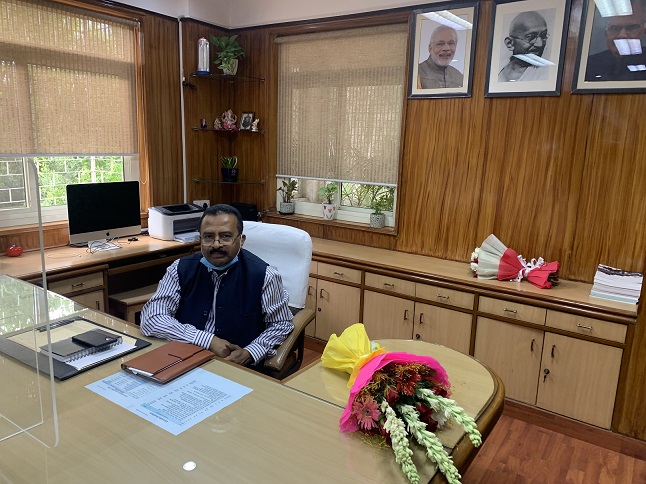Exploring the Impact of the New Education Policy on Indian Students and Institutions
Welcome to an exciting new era for education in India! The recently introduced New Education Policy (NEP) is set to revolutionize the way students learn, institutions operate, and knowledge is imparted.

Introduction to the New Education Policy (NEP)
Welcome to an exciting new era for education in India! The recently introduced New Education Policy (NEP) is set to revolutionize the way students learn, institutions operate, and knowledge is imparted. With its ambitious vision and comprehensive reforms, NEP promises a brighter future for Indian learners and educators alike. In this blog post, we will delve into the key changes brought about by NEP and explore their impact on both students and institutions. So fasten your seatbelts as we embark on a journey through the educational landscape of India that is poised for transformation!
Key Changes and Objectives of NEP
The New Education Policy (NEP) has brought about significant changes and set ambitious objectives for the Indian education system. One of the key changes is the focus on early childhood care and education, recognizing its crucial role in a child's overall development. The NEP also aims to ensure universal access to quality education by promoting inclusive practices and reducing disparities.
Another important change is the shift towards a 5+3+3+4 curricular structure, replacing the existing 10+2 system. This new structure emphasizes a strong foundational stage of three years followed by an exploratory stage of three years. It then leads to a middle stage of four years that promotes multidisciplinary learning, allowing students to choose subjects based on their interests and aptitudes.
The NEP also places emphasis on holistic learning, aiming to nurture critical thinking skills, creativity, problem-solving abilities, and social-emotional development among students. It encourages a more student-centric approach with reduced emphasis on rote memorization and standardized testing.
Furthermore, the policy envisions transforming higher education institutions into vibrant centers for research and innovation. It seeks to promote multidisciplinary studies by breaking down artificial barriers between different disciplines. This will enable students to pursue integrated courses that combine diverse fields of study according to their interests.
Internationalization of higher education is another objective highlighted in the NEP. The policy aims at attracting foreign universities while simultaneously encouraging Indian educational institutions to establish collaborations with international counterparts. This will expose students to global perspectives and enhance their competitiveness in an increasingly interconnected world.
While these changes bring many positive prospects for both students and institutions alike, there are also challenges associated with implementing such wide-ranging reforms across all levels of education in India. Adapting teaching methodologies, training teachers adequately, ensuring infrastructure availability are few areas demanding attention for successful implementation.
Overall,the New Education Policy introduces several progressive changes aimed at revolutionizing India's education sector.
The transformative impact it can have depends largely on effective execution and continuous monitoring. With the right strategies in place, NEP
Impact on Indian Students:
The New Education Policy (NEP) has brought about significant changes in the education system in India, impacting students across the country. One of the key changes is a shift towards a more holistic approach to learning. Gone are the days of rote memorization; instead, students are encouraged to explore and understand concepts deeply.
Moreover, the NEP also emphasizes multidisciplinary studies, allowing students to pursue diverse subjects beyond traditional boundaries. This opens up new avenues for exploration and helps develop well-rounded individuals who can think critically and creatively.
Additionally, there is renewed focus on vocational education and skill development, ensuring that students are equipped with practical knowledge that can be applied in real-world scenarios. This empowers them to make informed career choices and enhances their employability prospects.
Furthermore, the NEP emphasizes flexibility in curriculum design and assessment methods. It encourages schools to adopt innovative teaching techniques like experiential learning, project-based assessments, and collaborative problem-solving activities. This not only makes learning enjoyable but also fosters essential skills such as teamwork and communication.
These changes brought about by the NEP have a profound impact on Indian students by creating an environment where they can thrive academically while developing crucial life skills necessary for success in today's dynamic world.
- Changes in School Education
The New Education Policy (NEP) has brought about significant changes in the landscape of school education in India. These changes aim to revolutionize the way students learn and enhance their overall development.
One of the key changes is the introduction of a 5+3+3+4 curricular structure, replacing the traditional 10+2 system. This new structure focuses on foundational learning for children aged 3-8 years, followed by preparatory learning from ages 8-11, middle school education from ages 11-14, and finally secondary education from ages 14-18.
Another noteworthy change is the emphasis on early childhood care and education (ECCE). The NEP recognizes the importance of providing quality ECCE to children between three to six years old. This will lay a strong foundation for their future academic journey.
Moreover, there is a shift towards promoting multilingualism among students. The NEP encourages schools to teach at least two languages apart from Hindi or English. This move aims to preserve linguistic diversity while also enabling better cognitive development and cultural understanding among students.
Furthermore, there is an increased focus on experiential and holistic learning approaches rather than rote memorization. Students will have more opportunities for hands-on activities such as experiments, projects, arts, sports, and vocational skills training. This approach fosters critical thinking skills and equips students with practical knowledge that they can apply beyond textbooks.
Additionally, digital literacy has been integrated into school curriculum across all levels. With technological advancements shaping our world rapidly, it is crucial for students to be equipped with digital skills that are necessary for their future success.
These changes reflect a paradigm shift towards student-centric education that nurtures creativity,
critical thinking,and holistic development.
- Focus on Holistic Learning
One of the key changes brought about by the New Education Policy (NEP) is its focus on holistic learning. Gone are the days when education was solely driven by rote memorization and exam-oriented approaches. The NEP recognizes that students need to develop a well-rounded set of skills and knowledge in order to thrive in today's dynamic world.
Under the NEP, there is an emphasis on promoting critical thinking, creativity, problem-solving abilities, and communication skills among students. This means that apart from mastering academic subjects, students will also be encouraged to participate in co-curricular activities such as sports, arts, music, and community service.
By nurturing all aspects of a student's development – cognitive, emotional, physical, social – holistic learning aims to create individuals who are not only academically competent but also well-rounded human beings capable of adapting to various situations.
Holistic learning also extends beyond just classroom education. The NEP encourages schools to provide experiential learning opportunities for students through internships, apprenticeships or collaborations with industry professionals. This hands-on approach enables students to apply theoretical knowledge in practical settings and gain real-world experience.
Furthermore, the policy promotes interdisciplinary studies which allow students to explore multiple disciplines rather than confining themselves within narrow subject boundaries. For example,
a student interested in both computer science and psychology can pursue a course or project that combines elements from both fields. This multidisciplinary approach fosters innovation,
critical thinking, and problem-solving abilities as it requires connecting ideas from different disciplines to find creative solutions.
Overall, the focus on holistic learning under the NEP has immense potential for Indian students.
It equips them with essential life skills and prepares them for future challenges.
By encouraging a more comprehensive approach towards education, the NEP ensures that our young learners become well-rounded individuals who can contribute meaningfully to society.
- Encourages Multilingualism
Another significant change brought about by the NEP is its emphasis on multilingualism. The policy recognizes that India is a diverse country with over 1,600 languages spoken across different regions. To fully harness this linguistic diversity, the NEP proposes to implement a three-language formula in schools where students will learn three languages – their mother tongue (or regional language), a second Indian language and English.
The inclusion of the mother tongue as the medium of instruction at least until Grade 5 has several benefits. Research shows that children learn best when they are taught in their native language as it helps them grasp concepts faster and makes learning more relatable.
Moreover, this move also promotes inclusivity and preserves local cultures and traditions. By recognizing the importance of regional languages, the NEP aims to create an education system that caters to all sections of society.
Additionally, learning a second Indian language other than one's mother tongue will promote cultural exchange and understanding among students from different states. It will also enable students to communicate with people from various parts of the country, thereby fostering national integration.
Overall, encouraging multilingualism under the NEP has numerous advantages for students, including improved cognitive skills, enhanced cross-cultural understanding,
- Opportunities for Multidisciplinary Studies
The New Education Policy (NEP) in India has opened up exciting opportunities for students to pursue multidisciplinary studies. Gone are the days when students were confined to studying a single subject or stream. With the implementation of NEP, students now have the freedom and flexibility to explore multiple disciplines and create their own unique educational paths.
This shift towards multidisciplinary studies is aimed at fostering creativity, critical thinking, and problem-solving skills among students. It encourages them to think outside the box and make connections between different fields of knowledge. For example, a student interested in both biology and computer science can now combine these disciplines through courses like bioinformatics or computational biology.
By embracing multidisciplinarity, Indian students can acquire a more holistic understanding of subjects and develop versatile skill sets that are highly valued in today's rapidly changing job market. They will be better equipped to tackle complex real-world challenges that do not fit neatly into traditional disciplinary boundaries.
Moreover, this approach also promotes collaboration among various departments within educational institutions. It encourages educators from diverse backgrounds to come together and design interdisciplinary courses that integrate different perspectives and methodologies.
Multidisciplinary studies also pave the way for innovation by encouraging cross-pollination of ideas across disciplines. Students who engage in interdisciplinary learning are more likely to generate groundbreaking solutions by applying insights from one field to another.
The emphasis on multidisciplinary studies under NEP is a significant step towards nurturing well-rounded individuals with versatile skill sets. By providing opportunities for exploration across various domains, this policy empowers Indian students with the tools they need to thrive in an increasingly interconnected world where innovation often arises at the intersection of different disciplines
Impact on Indian Institutions:
The New Education Policy (NEP) has brought about significant changes in the landscape of Indian institutions. One key shift is towards a greater emphasis on research and innovation. With the aim of fostering a culture of inquiry and discovery, NEP encourages institutions to prioritize research activities across disciplines.
This focus on research not only benefits students by exposing them to cutting-edge knowledge but also contributes to the overall growth and development of the nation. By promoting collaboration between academia and industry, NEP seeks to bridge the gap between theoretical learning and practical application.
Another important aspect is the internationalization of higher education. NEP recognizes the need for Indian institutions to establish global partnerships, facilitate student mobility, and attract foreign faculty members. This exchange of ideas and perspectives will undoubtedly enrich the learning experience for students while also enhancing India's presence in the global educational arena.
Moreover, NEP promotes multidisciplinary studies that break traditional silos within educational institutions. This interdisciplinary approach allows students to explore various subjects simultaneously, encouraging creativity, critical thinking, and problem-solving skills.
While these changes hold immense potential for growth, they also present challenges that need to be addressed. Implementation at scale is a daunting task that requires adequate infrastructure, funding support, skilled faculty members, and well-designed curriculum frameworks.
Additionally,Critics argue that there should be more focus on skill development tailored towards employability rather than just academic excellence alone.
These concerns highlight an ongoing debate regarding balancing academic rigor with vocational training in order to produce well-rounded graduates who are ready for today's dynamic job market
In conclusion,the impact of NEP on Indian institutions cannot be overstated.
With its emphasis on research ,internationalization,and multidisciplinary studies,it aims at transforming our educational system into one that truly prepares students for success in an ever-evolving world.
However,to ensure its effectiveness,supporting infrastructure,funding,and addressing concerns raised by critics are crucial steps moving forward
- Shift towards Research and Innovation
The New Education Policy (NEP) aims to bring about a significant shift in the focus of Indian institutions towards research and innovation. This is a crucial step in ensuring that our education system keeps up with the fast-paced advancements happening globally.
Under NEP, there will be an increased emphasis on promoting research culture among students and faculty members. Institutions will be encouraged to establish dedicated research centers, collaborate with industry experts, and foster an environment conducive to innovative thinking.
This shift towards research and innovation holds immense potential for unlocking new opportunities for both students and institutions. It will help nurture critical thinking skills, problem-solving abilities, and creativity among students – qualities that are highly valued in today's competitive world.
Moreover, by encouraging multidisciplinary studies and cross-pollination of ideas across different fields of study, NEP paves the way for groundbreaking discoveries that can address complex societal challenges. This interdisciplinary approach fosters collaboration between various disciplines like science, technology, humanities, social sciences - ultimately leading to holistic growth.
By channeling resources into research initiatives within educational institutions itself rather than relying solely on external sources or industries; NEP promotes self-reliance in terms of knowledge creation. This not only strengthens India's position as a hub for cutting-edge research but also reduces dependence on other countries' technological advancements.
However, this shift does come with its own set of challenges. Institutions need to invest in infrastructure upgrades and create robust support systems for researchers. There must be sufficient funding allocated specifically towards R&D activities at all levels – from undergraduate programs to Ph.
D.s. Additionally; collaborations with industry partners must be nurtured to ensure translational impact from academia since real-world implementation is essential.
In conclusion; the shift towards research and innovation under the NEP has great potential for transforming Indian education into a powerhouse of knowledge creation while addressing societal needs effectively through multidisciplinary approaches.
- Internationalization of Higher Education
In today's interconnected world, the boundaries between nations are becoming increasingly blurred. This phenomenon has a significant impact on higher education as well. The New Education Policy (NEP) recognizes this and aims to foster internationalization in Indian institutions.
One of the key objectives of NEP is to make India a global knowledge hub by providing opportunities for collaboration with renowned international universities and promoting student and faculty exchange programs. This will not only enhance the quality of education but also expose students to diverse perspectives, cultures, and ideas.
By encouraging international collaborations, Indian institutions can tap into a wider pool of resources such as research grants, expertise from foreign faculty members, and access to cutting-edge technologies. Furthermore, exposure to different teaching methods and academic systems can help students develop critical thinking skills and broaden their horizons.
Promoting internationalization also opens up avenues for Indian students to pursue higher education abroad. With increased recognition of degrees obtained from Indian institutions globally, NEP seeks to create pathways for seamless credit transfers between universities across countries. This will enable students to explore educational opportunities abroad while still benefiting from the strong foundation provided by their home country.
However, it is important for institutions implementing these initiatives to ensure that they maintain high standards in terms of curriculum design, pedagogy delivery, and assessment methods. It is crucial that any partnerships or collaborations entered into are based on mutual respect and benefit rather than being driven solely by financial considerations.
In conclusion, The internationalization efforts outlined in NEP have immense potential in shaping the future landscape of higher education in India. By embracing global perspectives through collaborative endeavors with foreign institutions while maintaining our cultural identity and values intact we can truly prepare our students for success in an increasingly interconnected world.
Challenges and Criticisms of NEP
While the New Education Policy (NEP) has been applauded for its vision and potential positive impact, it is not without its fair share of challenges and criticisms. One major concern raised by critics is the implementation of the policy itself. With such a vast overhaul planned for the education system, ensuring smooth execution at every level will be no easy feat.
Another point of contention revolves around the proposed shift towards mother tongue or regional language as a medium of instruction until at least Grade 5. While this move aims to foster better understanding and cognitive development among students, some worry about the practicality in multi-lingual regions where English may still hold significant importance.
Moreover, there are concerns regarding the emphasis on vocational education and skills training. While equipping students with practical knowledge is crucial, critics argue that an excessive focus on vocational training may undermine traditional academic disciplines and limit educational opportunities for certain students.
Additionally, some experts question whether NEP's ambitious goals can be achieved within existing budgetary constraints. Implementing changes like transforming all schools into multidisciplinary institutions requires substantial financial resources that might not be readily available.
Furthermore, there are apprehensions about how NEP's proposals will affect marginalized communities and underprivileged sections of society who have historically faced barriers to quality education. It remains to be seen if adequate steps will be taken to ensure equitable access to educational opportunities for all.
These challenges highlight the need for careful planning, effective implementation strategies, regular monitoring mechanisms, and continued dialogue with stakeholders from across various sectors. Only through addressing these concerns can we strive towards achieving a truly inclusive and transformative education system that benefits all Indian students.
Conclusion: Balancing Progress and Adaptation
The New Education Policy (NEP) has undoubtedly brought about significant changes in the Indian education system, impacting both students and institutions. With its emphasis on holistic learning, multidisciplinary studies, research, innovation, and internationalization of higher education, the NEP aims to transform India's educational landscape.
For Indian students, these changes present new opportunities for a well-rounded education that goes beyond rote memorization. The focus on holistic learning will allow them to develop essential life skills such as critical thinking, problem-solving, creativity, communication skills, and emotional intelligence. Additionally, the introduction of multidisciplinary studies will enable students to pursue their interests across various disciplines and explore diverse career paths.
Indian institutions are also set to undergo a transformation under the NEP. The shift towards research and innovation will encourage universities to invest more in cutting-edge research facilities and foster an environment conducive to innovation. This can spur technological advancements and contribute to India's growth as a knowledge-driven economy.
Furthermore, the policy's emphasis on internationalizing higher education opens up avenues for collaboration with global academic institutions. This not only promotes cultural exchange but also provides Indian students with exposure to diverse perspectives and experiences that can further enhance their educational journey.
However, it is important to acknowledge that implementing such an ambitious policy comes with challenges. Adapting existing infrastructure and training educators accordingly may pose logistical hurdles initially. There might also be concerns regarding standardization across different states or regions within India.
Critics argue that certain aspects of the NEP lack clarity or need further elaboration before they can be effectively implemented. It is crucial for policymakers to address these concerns while ensuring transparent communication between all stakeholders involved in shaping India's future through education reform.
In conclusion (without using those words explicitly), striking a balance between progress and adaptation is key when implementing any sweeping policy change like the NEP. It requires continuous evaluation of its impact on students, educators, and institutions. By addressing challenges and incorporating feedback from all stakeholders, India's education system can successfully navigate towards a more holistic, multidisciplinary, and globally competitive future.











.jpg)




































